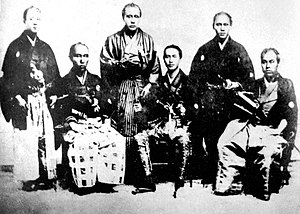Samurai sailors from the Kanrin Maru. (Wikipedia Commons)
This month marks the 150th anniversary of the first official Japanese embassy to the United States. In 1860, the Tokugawa shogunate government sent a group of samurai to America in order to ratify treaties between the two countries. The treaties were the result of the visit by the American "Black Ships" in 1853 headed by Commodore Matthew Perry whose purpose was to "pry open" the country of Japan. Although there had been a small handful of Japanese who had visited the United States previously, this official visit attracted much attention and curiosity among the citizens of San Francisco and the nation. Thousands lined the shore in San Francisco to watch the arrival of the Kanrin Maru, the small Japanese ship manned by samurai sailors. The Kanrin Maru was piloted by Katsu Kaishu, the man who would be the mentor to Sakamoto Ryoma, one of the famous leaders of the Bakumatsu period and the restoration of the emperor.
Newspapers reported on the visit to the smallest of details and reflected on the popular view of the time at how awed these visitors would be as they encountered Western civilization and American progress. However, that outlook changed when the stately, and always polite, Japanese ambassadors occasionally encountered rowdy crowds who mobbed them to get a glimpse of the exotic Japanese. Dismayed by these unseemly popular displays, some editorials began asking just who was really more "civilized".
While the Kanrin Maru and her crew remained in San Francisco for a period of time before returning to Japan, the embassy leaders traveled to Washington to meet President Buchanan at the White House where they were treated to formal dinners. In New York, the Japanese were welcomed by a grand parade up Broadway watched by half a million people. Unfortunately the excitement of the embassy was soon washed away by the civil wars that engulfed both nations later in the 1860s.
To mark the historic event, the city if San Francisco dedicated a bronze plaque last week at Pier 9 to honor where the samurai from the Kanrin Maru came ashore on March 17, 1860. Other events will include the planting of sakura trees in Japantown and a visit by a Japanese tall ship on May 5th as well as an exhibition at the Asian Art Museum called "Japan's Early Ambassadors to San Francisco."

President Buchanan receiving the embassy in Washington. (Wikipedia Commons)

.jpg)







